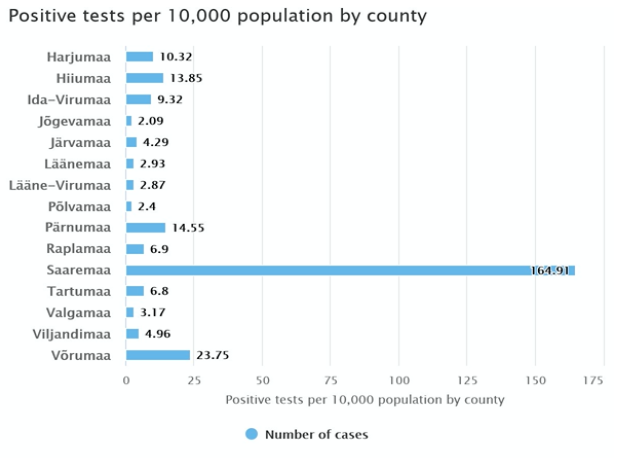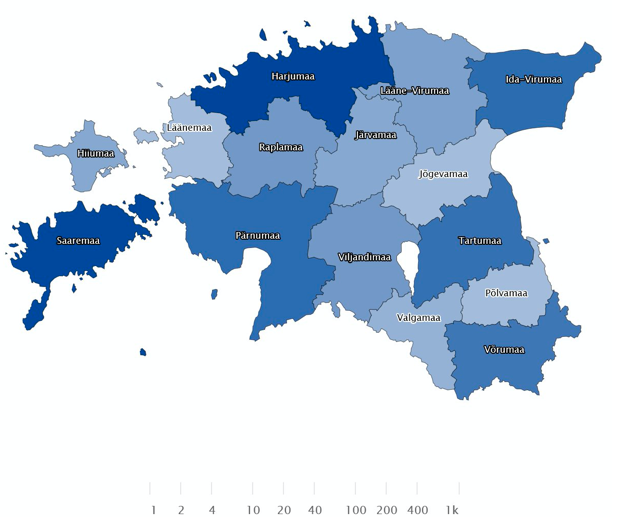Weekly Briefing, Vol. 28, No. 3 (EE), April 2020
Understanding and waiting patiently… Until when?
When any serious crisis is on, any normal Government would, presumably, prefer knowing how the country’s population is coping with the crisis-associated issues. The COVID-19 is not an ordinary challenge for any society, big or small. On the multi-faceted societal community of Estonia, the pandemic has made a distinctly dualistic impact. Firstly, a highly globalised nation, Estonians enjoy travelling, while being free to move to almost anywhere and discover almost anything. This is not quite a possibility at the moment. However, secondly, a very local society, having ‘arrived’ into prosperity and ‘grown up’ into its nationhood from the peasantry, Estonia is capable of switching its ‘gears’ into resilience almost at any given moment. The COVID-19-generated global chaos has framed up the time to do so, and this is what Estonia has successfully done – the country has simply adopted a particular mode to act as a 1.3 million strong resilient society. A survey, conducted in April by the Estonian National Institute for Health Development (Tervise Arengu Instituut), mapped out the Estonian people’s awareness, behaviour and attitudes in the current emergency situation, proving the point made.
For example, the survey showed a very high level of societal understanding on what the country is facing – 86% of the respondents noted that the virus is perceived by them as “dangerous or very dangerous”, and the “the perceived level of threat was highest among women, the elderly and people with higher education”[1]. In a significant addition, a bit more than 50% of the survey’s participants confirmed their self-isolation at home during the state of emergency; especially, such a practice was reported by the societal segment of “over 65”,[2] which, arguably, prevented the virus from spreading exponentially in Estonia. Finally, the survey underscored that “98% of people regularly wash their hands with soap and 89% disinfect their hands”, while, in general, the respondents confirmed that they are “not attending events and gathering and are keeping a distance of at least two meters from other people, particularly those exhibiting virus symptoms”[3]. These results were treated as encouraging by Sigrid Vorobjov, Head of the Centre for Prevention of Drug Addiction, who made the following statement on the matter:
We were happy to observe that people are keeping a close eye on information channels and wish to contribute to curbing the spread of the virus. People’s attitudes with regard to restrictions are supportive – they are trying to prevent contact with other people and are making an effort to ensure hand hygiene; however, it also appeared that over half of the respondents are more stressed out or anxious than usually.[4]
The final bit of the above statement sounded undeniably realistic – a relative level of societal resilience, which can be quantifiably determined, does not, however, allow the state to dwell on it for a long time. Whatever it is, – either the nation’s unmatched patience or its resilient attitude, – it can quickly get to the ‘pushing-the-limits’ stage. Such a concern was well picked up by Mihhail Kõlvart (Centre Party), Mayor of Tallinn. The experienced politician who, despite his relatively young age, seems to have mastered a skill of walking on a fine line between populism and realism, reflected on the current status quo in a comprehensive manner:
The easing of measures needs to be planned as simply lifting all restrictions at once is unthinkable. I can see a dangerous coeffect of circumstances where people are tired of restrictions, the weather is beautiful and we are hearing positive signals of alleviation and exiting the crisis. The results of this have already manifested. […] The number of children who attend kindergarten, public transport passenger figures – they [a]re all growing. If at the beginning of the emergency situation we had on average 1,200 children attend kindergarten, the number has now grown to 1,800 (Tallinn has a total of 22,000 pre-schoolers). More and more people are taking public transport too. […] Our goal right now is to prevent a new wave inside the current epidemic. We are on relatively thin ice here.[5]
The idea, which the Mayor of the country’s capital as well as largest city wanted to underscore, was very obvious – the society of the Republic of Estonia should do their utmost best to avoid a situation when the whole country will be put on hold once more. On 30 April, Estonia had 1,694 of the confirmed COVID-19 cases, losing 54 people by then and having 7 in intensive care[6]. For a relatively small country where every person’s life is treasured and every loss is remembered, it was already 1,694 people too much. Additionally, the virus made its tremendous ‘footprint’ on the nation’s economic life and cross-societal interconnections. The country’s largest island, Saaremaa[7], was/is the worst hit – by the end of April, the island had 545 cases out of the total number of confirmed cases (only 49 cases less than Estonia’s most populated county, Harjumaa, where Tallinn is also located). The problem, however, is that the number of positive tests per 10,000 population is about 16 times higher on Saaremaa, if compared to the same Harjumaa (please see Table 1 for more details). For a better visibility, Figure 1 shows how the total number of cases is ‘distributed’ across the country, with the darker segments of the map indicating those counties with a higher number of the recorded cases.
Table 1

Source: Koroonakaart
Figure 1

Source: Koroonakaart
Another major societal issue that was brought up by the COVID-19 was (and still is) related to education. The country’s youngsters are among the world’s most performing, academic skill wise. Evidently, Estonia is the European continent’s leading nation in education (No 1. in PISA test in Europe)[8], and its 15-year-old students have just been confirmed by the global OECD PISA 2018 financial literacy assessment as the “world’s most financially literate”[9]. Indeed, it would be something to keep up, and going down from these heights – because of the crisis or for any other reason – would not be tolerated socially, economically and politically. In such a context, it was very important for the public to hear the President’s take on how the nation’s future – the children of Estonia – is combating the COVID-19. Kersti Kaljulaid, who was, in fact, relatively quiet during the pandemic (speculatively speaking, she was, probably, did it intentionally to allow the Government to take responsibility and perform to the best of their abilities), addressed one of her latest messaged directly to the youngsters, acknowledging their efforts:
It is a beautiful spring, but we have stayed indoors a little bit more this year. We have definitely been more thoughtful this spring because we all have had to contribute to the future of Estonia, a contribution which is observable every day. […] On the day when the emergency situation will end in Estonia, when current restrictions will be eased and we can more freely to visit stores, maybe restaurants, one day cinemas and theatres; it will still be our responsibility to wash our hands until the virus has disappeared for good, to keep a safe distance with others, maybe even wear a mask while using public transport. […] In any case, we have to be vigilant and stay at home when feeling ill. This will help protect us from not only the coronavirus but from other diseases. I thank you for your efforts, we have to try a little bit more and freedom will be slightly different this summer. […] Thank you, dear children, for being so understanding.[10]
Arguably, it was rather a message from a mother of four than the country’s President. At the same time, each society needs a personal touch from the governing bodies – especially, when the whole international system is challenged by an unexpected global danger. There is a life to live after this new virus gets settled into its new localities, and Estonian society needs to be ready to get on with normal life.
[1] ‘Study: Estonians understand necessity of restrictions’ in ERR, 27 April 2020. Available from [https://news.err.ee/1082885/study-estonians-understand-necessity-of-restrictions].
[2] ‘Study: Estonians understand necessity of restrictions’.
[3] ‘Study: Estonians understand necessity of restrictions’.
[4] Sigrid Vorobjov in ‘Study: Estonians understand necessity of restrictions’.
[5] Mihhail Kõlvart in Toomas Sildam, ‘Mihhail Kõlvart: Life cannot be put on hold for a second time’, ERR, 24 April 2020. Available from [https://news.err.ee/1082040/mihhail-kolvart-life-cannot-be-put-on-hold-for-a-second-time].
[6] ‘Koroonakaart’. Available from [https://www.koroonakaart.ee/en].
[7] Saaremaa, 2,673 km2, is located in the Baltic Sea and belongs to the West Estonian Archipelago. Its area is compared to Moresby Island (BC, Canada), North Andaman Island (India), and Kupreanof Island (Alaska, U.S.A.).
[8] ‘Estonian example: vocational education and remote learning is possible’ in Estonian Ministry of Education and Research, 22 April 2020. Available from [https://www.hm.ee/en/news/estonian-example-vocational-education-and-remote-learning-possible].
[9] ‘PISA assessment ranks Estonian students as world’s most financially literate’ in Estonian Ministry of Education and Research, 22 April 2020. Available from [https://www.hm.ee/en/news/pisa-assessment-ranks-estonian-students-worlds-most-financially-literate].
[10] Kersti Kaljulaid in ‘President thanks children for their efforts during crisis’, ERR, 28 April 2020. Available from [https://news.err.ee/1083290/president-thanks-children-for-their-efforts-during-crisis].
